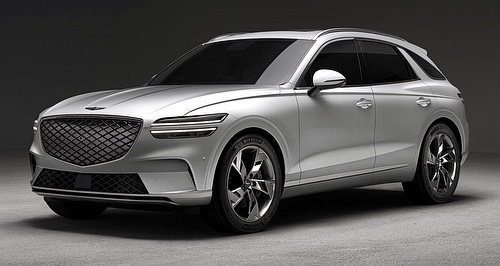Make / Model Search
News - Market Insight - Market Insight 2022Market Insight: H1 winners and losersOn the up: Luxury brand Genesis performed well in the first half of this year with Australian deliveries up 79.5 per cent, aided by popularity of the GV70 medium SUV.
Shortages, delays cause H1 sales slump for 26 brands as new-car demand surgesGallery Click to see larger images 1 Aug 2022 By NEIL DOWLING THE Australian new-vehicle market is turning into a scene from Struggle Street with erratic and mostly extended delivery delays failing to dent the pent up demand for new vehicles.
It has led to a roller-coaster delivery schedule that has warped the monthly performances of brands with even the strongest sellers reporting negative sales.
Some brands have posted significant increases just by coming off a small base, where selling double the cars – in some cases just five units – is a 100 per cent improvement.
Others make the jump because, literally, their ship came in. Following production hiccups from pandemic-related labour shortages to the ongoing semiconductor squeeze, any increase in flow-through at the factory will quickly balloon deliveries and appear that a brand, or model, is suddenly very popular.
Sometimes that is true, especially with the launch of a new model. At other times it is just a catch-up.
For all the production delay problems, it is no surprise that in the year-to-date June VFACTS data, there were more brands delivering negative sales results than those with increases on the same period in 2021.
Citroen showed the biggest jump over 2021, with its first six months of 2022 recording 172 sales for a 142.3 per cent leap.
Although the C3 Aircross ended its run, the brand’s performance was lifted by the new C4 (67 sales this year), the C3 hatch (56 sales for a 19.1 per cent increase) and the C5 Aircross that found 49 buyers, up 133.3 per cent on the previous period.
Genesis also performed well, up 79.5 per cent with 463 sales. Most of the attention is on the GV70 SUV, particularly the rapid V6 bi-turbo petrol.
South Korea’s competitor to the Audi Q5, BMW X3, Jaguar E-Pace, Lexus NX, Mercedes-Benz GLC and Volvo XC60 sold 258 units this year, up 706.3 per cent on the 32 units delivered in the previous corresponding period. The range will be boosted by a trio of all-electric choices between now and the end of this year..
The brand also won 12 sales in June – and for the year – for its latest all-electric GV60, and 37 sales of its G80 executive sedan, up 32.1 per cent, while production hiccups trimmed the GV80 SUV to 116 sales, down 24.7 per cent.
Another winner was Renault, up 45.5 per cent for the six months with 5068 sales. Its new Arkana small crossover – which replaces the Kadjar – has been a hit with 648 sold.
Renault also picked up buyers for its light SUV, the Captur, with 750 sales – up 212.5 per cent on last year – and its enduring mid-size Koleos SUV that sold 1717 in the period, remaining the brand’s biggest seller in Australia.
Other winners in the half year included Lotus – as buyers and collectors become attracted to the iconic brand ahead of its move to full electrification – as well as Ram and Rolls-Royce. Lotus sales are up 100 per cent with 62 deliveries (45 being the Exige) while big moves on Ram’s larger 2500 and 3500 helped the US pick-up truck brand lift deliveries by 36.3 per cent to 2572 units and Rolls-Royce achieved 33 sales, led by 17 sales of the Cullinan SUV to grow by 43.5 per cent.
Crippled by issues such as the poor supply of semiconductors were brands such as Lamborghini, which reported no coupe or convertible deliveries this year. Lamborghini told GoAuto there had been no supply available to Australia so far this year but that deliveries start again this month.
Lamborghini has sold 44 units this year, all the Urus SUV. Even that was down on last year’s six-month figure of 46 SUVs and the additional 35 units of sportscars. As such, its overall first-half sales are down 45.7 per cent.
Supply issues hobbled Jaguar Land Rover’s factories and global deliveries, causing Jaguar sales to be down 41.3 per cent at 413 units, and Land Rover fell 32.7 per cent with 2601 sales.
The biggest hit to the latter was the change to a new-generation Range Rover, causing deliveries of the flagship model to reach only 32 units compared with 129 of the previous generation in 2021.
Nissan also fell, down 36.4 per cent with 15,249 sales. Its slide was attributed to disappearing models – the 370Z finished with 15 sales in the six months, down from 70 in 2021; the GT-R contributed only nine sales compared with 17 previously; the Pathfinder ended; and the mainstay X-Trail and Qashqai wound down awaiting the new model.
X-Trail sales halved to 3955 in the first six months of 2022, while Qashqai stock dried up to leave just nine units delivered compared with 4737 in the first half of 2021.
Skoda and Volkswagen were also down with sales plunging 41.9 and 37.5 per cent respectively, 15 of the Volkswagen models posting negative sales compared with 2021 as shipping and semiconductor issues bit hard.
Better news was found in an 87.5 per cent lift for Golf sales, a 28.7 per cent increase for the Passat and the 211 units added through the introduction of an updated Arteon.
All except one Skoda model – the Superb that showed a 16.1 per cent jump to 432 sales – fell.  |
Click to shareMarket Insight articlesResearch Market Insight Motor industry news |










Facebook Twitter Instagram